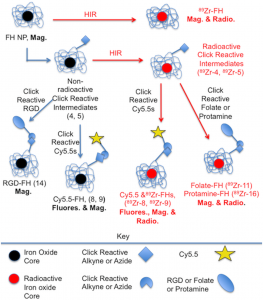Yuan H, Wilks MQ, El Fakhri G, Normandin MD, Kaittanis C, Josephson L (2017) Heat-induced-radiolabeling and click chemistry: A powerful combination for generating multifunctional nanomaterials. PLoS ONE 12(2): e0172722. doi:10.1371/journal.pone.0172722
Abstract

A key advantage of nanomaterials for biomedical applications is their ability to feature multiple small reporter groups (multimodality), or combinations of reporter groups and therapeutic
agents (multifunctionality), while being targeted to cell surface receptors. Here a facile combination of techniques for the syntheses of multimodal, targeted nanoparticles (NPs) is presented, whereby heat-induced-radiolabeling (HIR) labels NPs with radiometals and so-called click chemistry is used to attach bioactive groups to the NP surface. Click-reactive alkyne or azide groups were first attached to the nonradioactive clinical Feraheme (FH) NPs. Resulting ªAlkyne-FHº and ªAzide-FHº intermediates, like the parent NP, tolerated 89Zr labeling by the HIR method previously described. Subsequently, biomolecules were quickly conjugated to the radioactive NPs by either copper-catalyzed or copper-free click reactions with high efficiency. Synthesis of the Alkyne-FH or Azide-FH intermediates, followed by HIR and then by lick reactions for biomolecule attachment, provides a simple and potentially general path for the synthesis of multimodal, multifunctional, and targeted NPs for biomedical applications.

